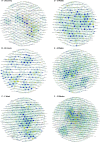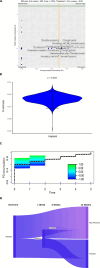This is a preprint.
Community dynamics during de novo colonization of the nascent peri-implant sulcus
- PMID: 39711569
- PMCID: PMC11661366
- DOI: 10.21203/rs.3.rs-5390824/v1
Community dynamics during de novo colonization of the nascent peri-implant sulcus
Update in
-
Community dynamics during de novo colonization of the nascent peri-implant sulcus.Int J Oral Sci. 2025 Apr 29;17(1):37. doi: 10.1038/s41368-025-00367-7. Int J Oral Sci. 2025. PMID: 40301331 Free PMC article.
Abstract
Dental implants have restored chewing function to over 100,000,000 individuals, yet almost 1,000,000 implants fail each year due to peri-implantitis, a disease triggered by peri-implant microbial dysbiosis. Our ability to prevent and treat peri-implantitis is hampered by a paucity of knowledge of how these biomes are acquired and the factors that engender normobiosis. Therefore, we combined a 3-month interventional study of 15 systemically and periodontally healthy adults with whole genome sequencing, fine-scale enumeration and graph theoretics to interrogate colonization dynamics in the pristine periimplant sulcus. We discovered that colonization trajectories of implants differ substantially from adjoining teeth in acquisition of new members and development of functional synergies. Source-tracking algorithms revealed that this niche is initially seeded by bacteria trapped within the coverscrew chamber during implant placement. These pioneer species stably colonize the microbiome and exert a sustained influence on the ecosystem by serving as anchors of influential hubs and by providing functions that enable cell replication and biofilm maturation. Unlike the periodontal microbiome, recruitment of new members to the peri-implant community occurs on nepotistic principles. Maturation is accompanied by a progressive increase in anaerobiosis, however, the predominant functionalities are oxygen-dependent over the 12-weeks. The peri-implant community is easily perturbed following crown placement, but demonstrates remarkable resilience; returning to pre-perturbation states within three weeks. This study highlights important differences in the development of the periodontal and peri-implant ecosystems, and signposts the importance of placing implants in periodontally healthy individuals or following the successful resolution of periodontal disease.
Conflict of interest statement
Competing interests: None of the authors have any competing interests to declare.
Figures







References
-
- NIDCR. Tooth Loss Among Adults 20–64. 2014. Available from: http://www.nidcr.nih.gov/DataStatistics/FindDataByTopic/ToothLoss/ToothL...
-
- Jain N, Dutt U, Radenkov I, Jain S. WHO’s global oral health status report 2022: Actions, discussion and implementation. Oral Diseases. John Wiley and Sons Inc; 2023. - PubMed
-
- Brånemark PI. Osseointegration and its experimental background. J Prosthet Dent. 1983. Sep;50(3):399–410. - PubMed
-
- Becker W, Becker BE, Newman MG, Nyman S. Clinical and microbiologic findings that may contribute to dental implant failure. Int J Oral Maxillofac Implants. 1990;5(1):31–8. - PubMed
Publication types
Grants and funding
LinkOut - more resources
Full Text Sources

